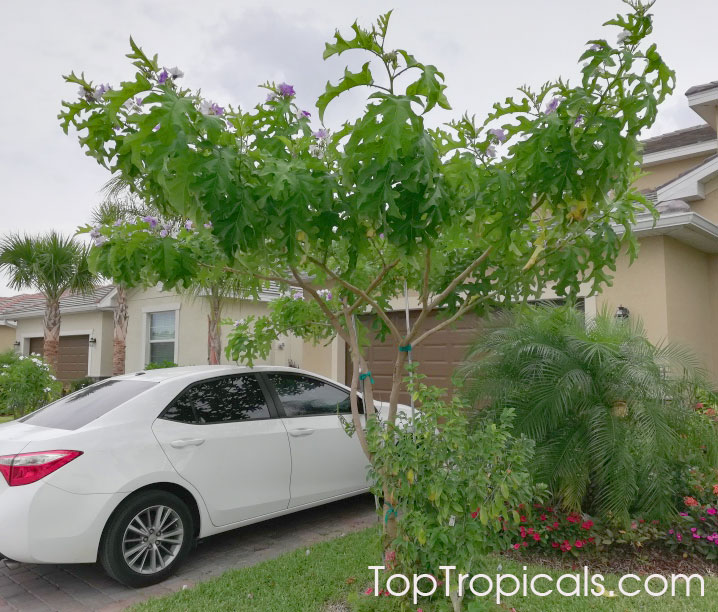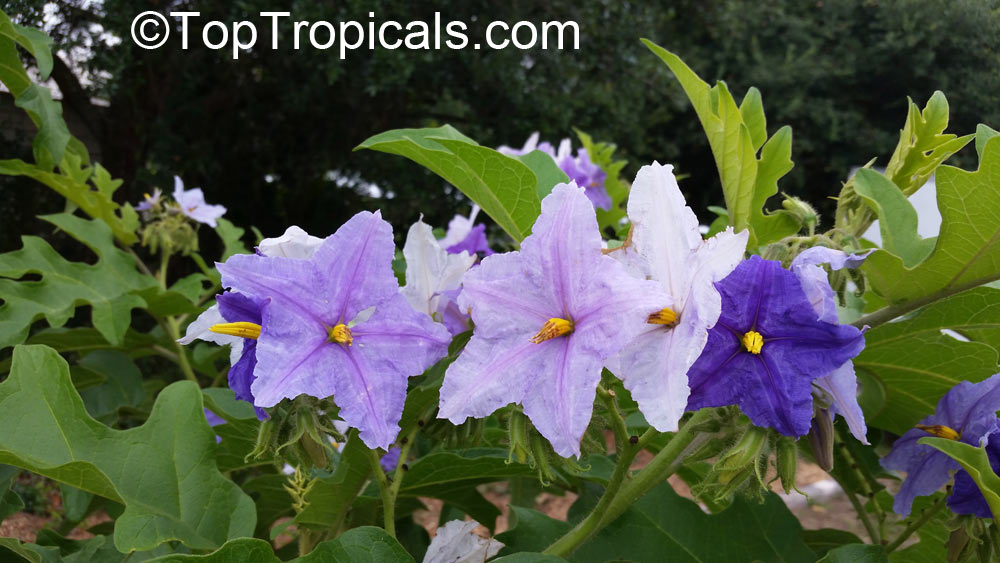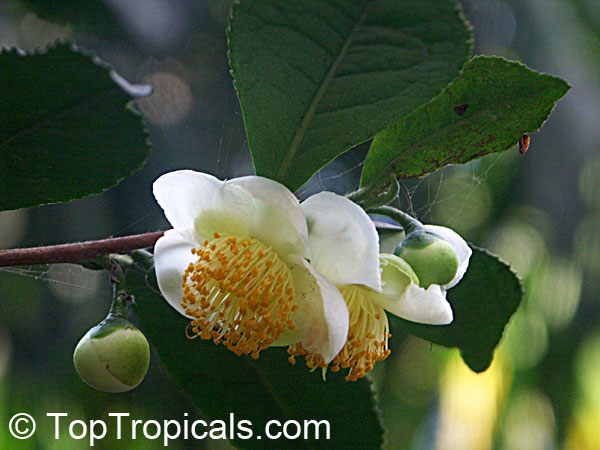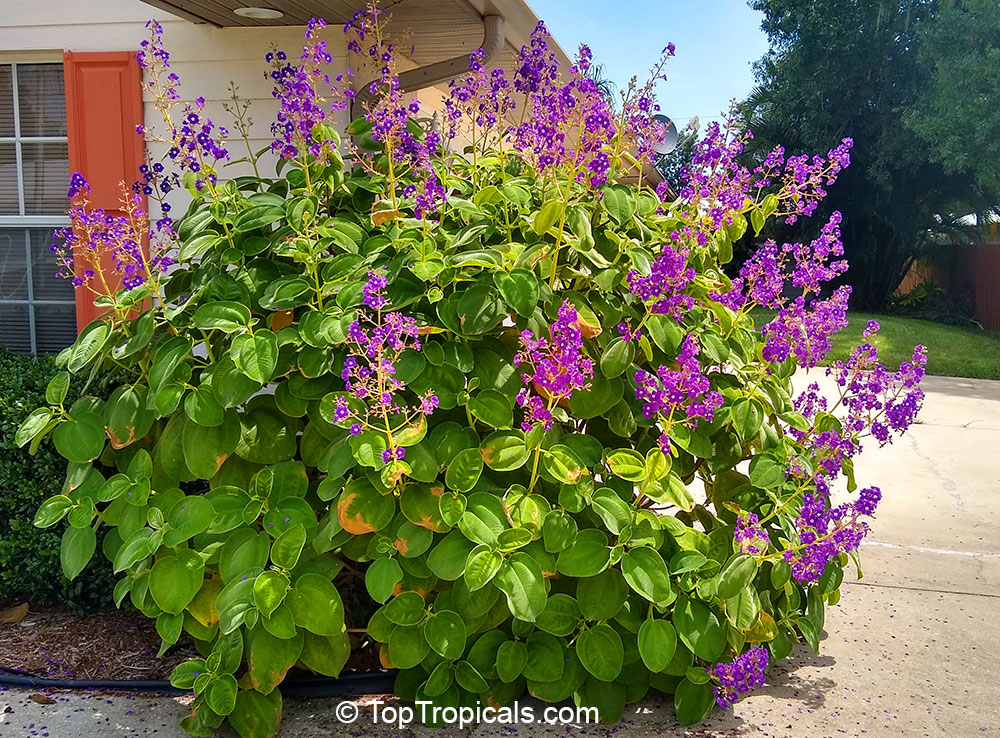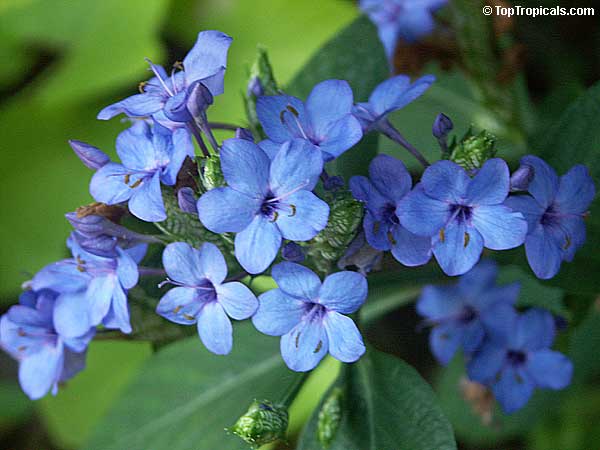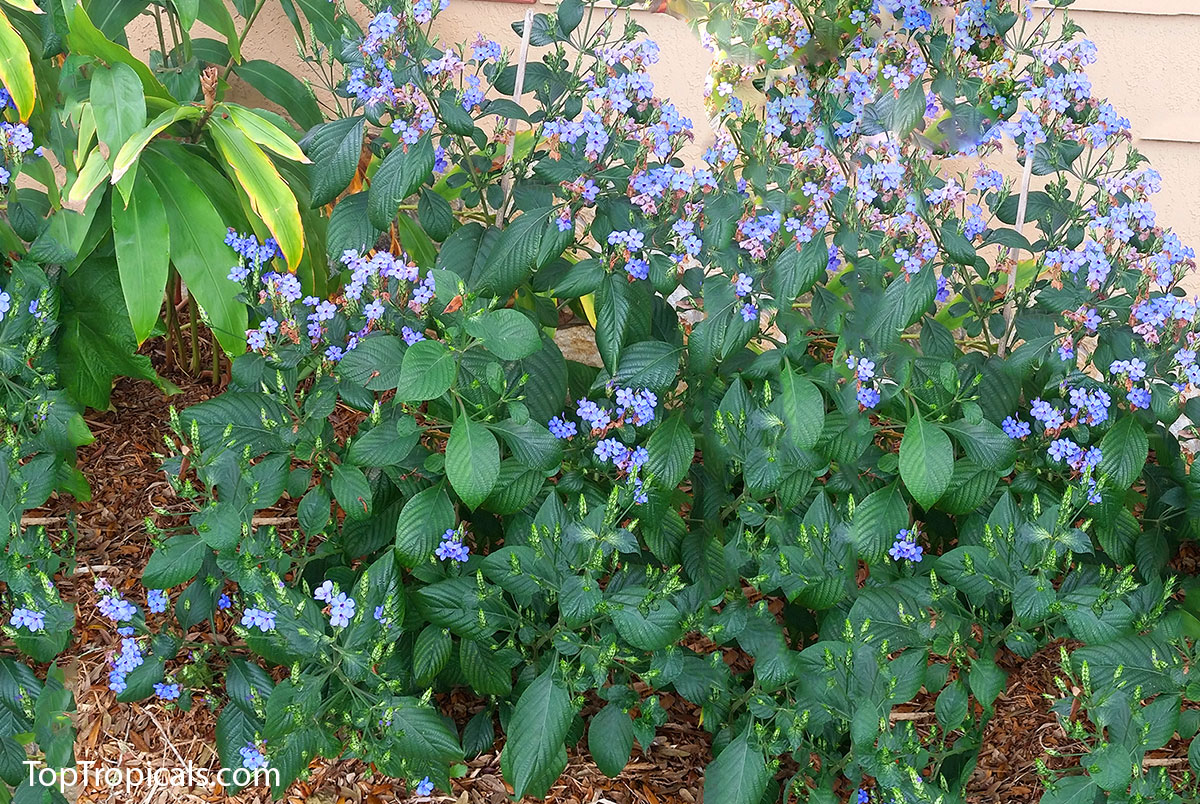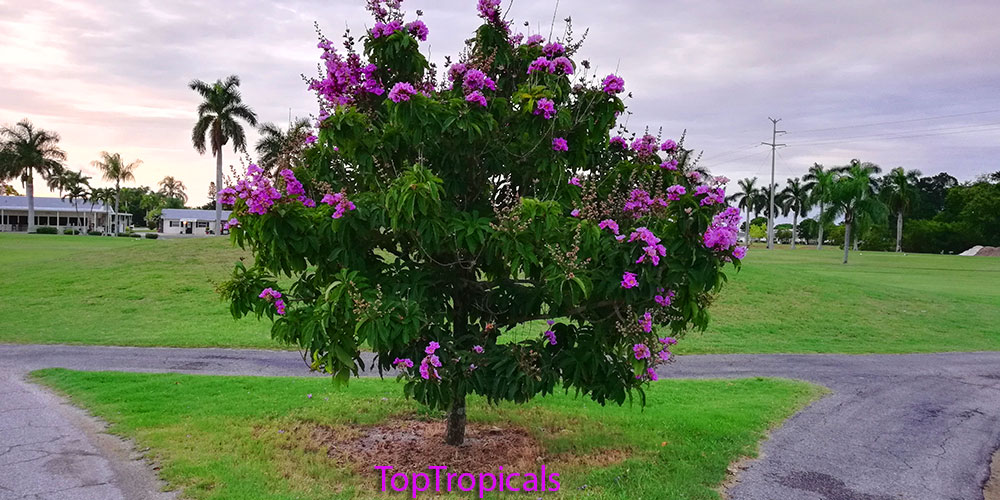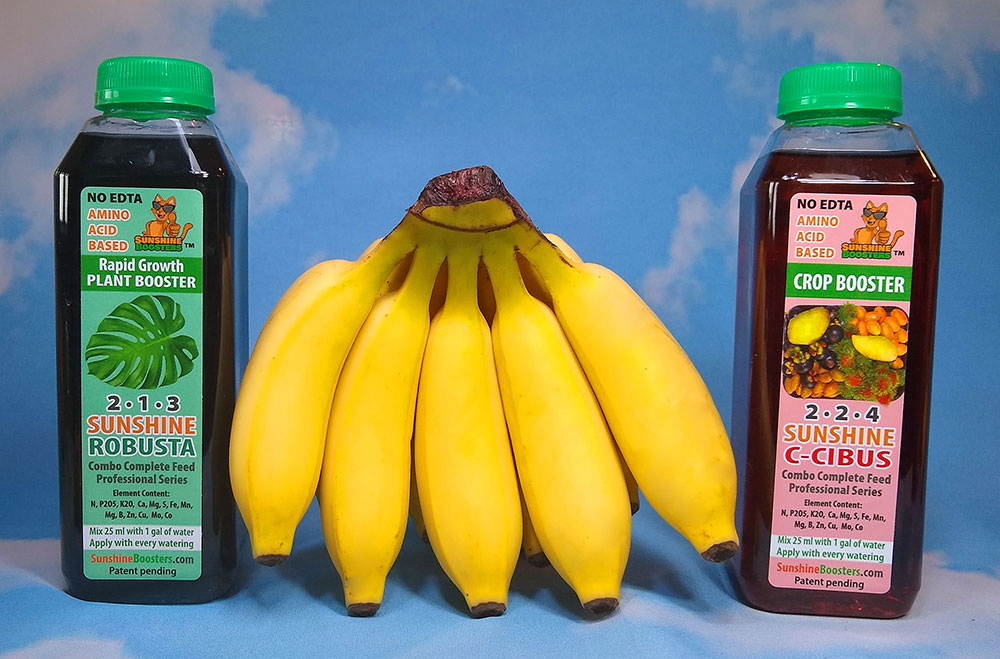Garden Blog - Top Tropicals
Date:
How to get shade quickly... and stay away from oaks
Q: I just moved from Tennessee into a new house in Florida and there are no trees on the property, the yard is brutal hot. What can I plant so I have some shade real quick? I like Florida shady oaks, how long will they take to grow?
A: First
of all, do not rush into oak solution. Oaks are beautiful shade trees, however
they have at least 2 problems:
a) Oaks are slow growers and unless you are willing to wait some 20
years... you won't get that desirable shade that quickly.
b) We have hurricanes in Florida... sometimes. A hurricane can damage
any tree, however with oaks it may be the worse case scenario - the branches
of those giant trees are huge, hard and heavy and in unfortunate situation
when you need to remove or trim a broken tree, it may cost you... a few thousand
dollars.
These are solutions that are more economical and practical:
1) Selection. If you have room, get one of these most popular Florida shade trees: Royal Poinciana, Golden Shower, Hong Kong Orchid Tree, Red Kapok, Bottlebrush, and many others. See full list of fast growing shade trees. Or simply get a Mango Tree and have delicious fruit too! Many varieties of Mangos are very large and fast growing.
2) Do it right. Even if you are planting a smaller tree, 1-3 gal
size, it may become a nice shade tree within 2-3 years and start providing
your driveway with desirable shade. The keys for fast growth are -
a) Good soil. Dig as big hole as possible and fill it with good
rich soil containing compost. See planting instructions PDF.
b) Water. Do not rely on sprinklers and rains. Water your tree
daily for the first week, then at least twice a week for another month. After
that, irrigation system will be enough.
c) Fertilizer. Put a few handfuls of fertilizer in a planting hole. Then fertilize once a month during warm
season. Apply micro elements for even better results and faster growth.
3) Ask experts. Contact our office for advice. We will suggest the most suitable shade tree for your yard based on features of your property: location, soil, exposure, etc.
Date:
Full Sun Garden vs Shade Garden
"Someone is sitting in the shade today because someone planted a tree a long time ago." (Warren Buffett)
Q: I live in California and I have a large area of my garden in full shade. Are there any plants that will be happy there? I am looking for something colorful. I also have a smaller area in front of the house that has full sun almost all day long, but I am afraid this can be too hot for flowering plants? Can you recommend something?
A:
Full sun gardens have a strong, bright look while shade
gardens have cooler, subdued appearance. Both types of
gardens are fun to design and maintain as long as you pick
the right plants.
Full Sun Garden is the easiest to grow. Depending
on exposure, it may require some plants that can tolerate
the hottest summer days and the dry conditions in your
area. The good news is, the majority of tropical and
subtropical plants prefer full sun, so you have a large
selection to pick from - fruit trees, flowering trees,
shrubs, vines, and small perennials. The more sun, the
more flowers and fruit you will get! However, keep in mind
that sun gardens require more water, but generous mulching
will help to minimize watering.
Shade Garden is much more restful in appearance,
but sometimes may be a little more difficult to work with.
As shade trees grow bigger and thicker, it may become too
dark; nothing will grow in total darkness. In this case
you need to prune back some branches to let more light in.
Filtered sunlight or dappled light coming through the
leaves of the trees is beneficial and considered light
shade, which would be the best light conditions for shade
loving plants to thrive. Although shady cooler spaces
attract more insects and will require more attention to
control them, they also have some advantages over sun
gardens. You can enjoy working in cooler conditions, and
your garden will require less water. Many foliage plants
look more deeply colored and healthier than in full sun;
white flowers shine instead of looking washed out!
Our favorite shade plants are fragrant brunfelsias , clerodendrums, and of course
colorful gingers and heliconias. You
may also consider ornamental foliage of Calatheas, lush Alocasias, Colocasias, and colorful Cordylines. Check out our shade loving plant list for
more colorful suggestions. These are also great for indoor
gardens!
Date:
Quick shade for your driveway
Q: Please help! We just moved into a new house in Florida and don't have any mature trees yet, but the sun is already brutal! Can you suggest any super-fast growing shade tree that can make shade over my driveway as soon as possible?
A: Check out Giant Potato Tree - it is very fast growing, has very large leaves plus very pretty purple flowers as a bonus year round! The pictured tree was planted from 3 gal only 6 months ago, and already covers with shade the whole car. It is small to a medium size tree, but one of the fastest growing. If you are looking for a larger tree and willing to be more patient, here is the full list of tropical and subtropical fast growing shade trees. Most of them may take a few years until they reach a mature size, however, in order to enjoy your shade tomorrow, you must plant the tree today!
Longevity Spinach Superfood Recipes: how to make healthy food delicious
Can healthy food taste delicious?
Healthy Longevity Spinach... It tastes like... spinach? You can add it to your salads, but let's face it, you can only eat so much of a salad. So try it cooked - you will be so surprised and want to eat it every day!
🍳 Eggs with Longevity Spinach
You will need:
🌿 Longevity Spinach or Okinawa Spinach: 2 handfuls
- 1 cup Bacon (optional), sliced or chopped, or: 2 tbsp Olive or vegetable oil
1 large Onion, sliced in semi-rings
1 sweet pepper, red or yellow, sliced
3-5 cloves garlic, chopped (optional, to taste)
5-6 eggs
1 cup ground beef or turkey/chicken (optional), or mushrooms
½ cup shredded cheese (regular or Parmesan)
salt and pepper to taste
🌶 Sweet Chile Sauce (optional. Tastes great with this dish!)
- 🍷 a glass of your favorite wine or cocktail to enjoy your dinner
Preparation time: 10 min
Makes dinner for 2
Open detailed recipe
🛒 Order Longevity Spinach
#Edible_Forest #Recipes
TopTropicals.com
We Grow Happiness
Date:
A Cup of Tea Plant
By Onika Amell, tropical plant specialist
A: I live in Ave Maria, Florida. I want to try my hand at growing my own tea. Which plant do I need?
A: Most people do not realize they are actually enjoying
camellias when they sip their cup of tea. True tea comes from the Camellia sinensis
plant, an evergreen shrub or small tree.
In the fall and winter, the plant will produce small white flowers with
a lovely fragrance. The foliage is shiny and dark green with a very nice
informal and open look.
Camellia sinensis (or tea plant, as it is commonly known) prefers a
temperature between 65 and 86 degrees, which makes Florida an ideal area to grow
them. However, if you live in colder zones, you can certainly succeed
growing your own tea plants using a greenhouse. Alternatively, you can use
containers which can be brought inside when temperatures start falling. Tea plants
will usually survive a very slight freeze, though the leaves may be damaged or
killed. It will not tolerate a hard freeze. They prefer full sun or light
shade in the garden.
Tea plants will become small trees or large bushes if not pruned.
Hardcore tea growers trim back the shoots repeatedly to a height of around 4 feet
to encourage new growth and to contain the size.
Make sure to pick an area of your landscape where it does not flood or
remain wet during our rainy season. Camellia sinensis does not like wet feet
at all. They prefer well-drained, sandy and slightly acidic soil. If grown in
a container, add some sphagnum moss to the potting mix. They will benefit
from frequent applications of small amounts of fertilizer.
You will need some patience, too. Your plant should be around 3 years old
before you start harvesting leaves.
Recommended fertilizers:
Tropical Greenhouse Plus - Plant Booster
Tropical Allure - Smart-Release Booster
Harvesting recipes
Now that you know how to grow the Tea, you need to check this out: the Harvesting recipes how to harvest and make different kinds of real tea: Green Tea, Japanese Style Green Tea, Oolong Tea, Black Tea, Orthodox Indian Tea... Continue reading...
What does a dragon taste like? Does Dragon Fruit come from a monster cactus? Learn why you need to grow your own
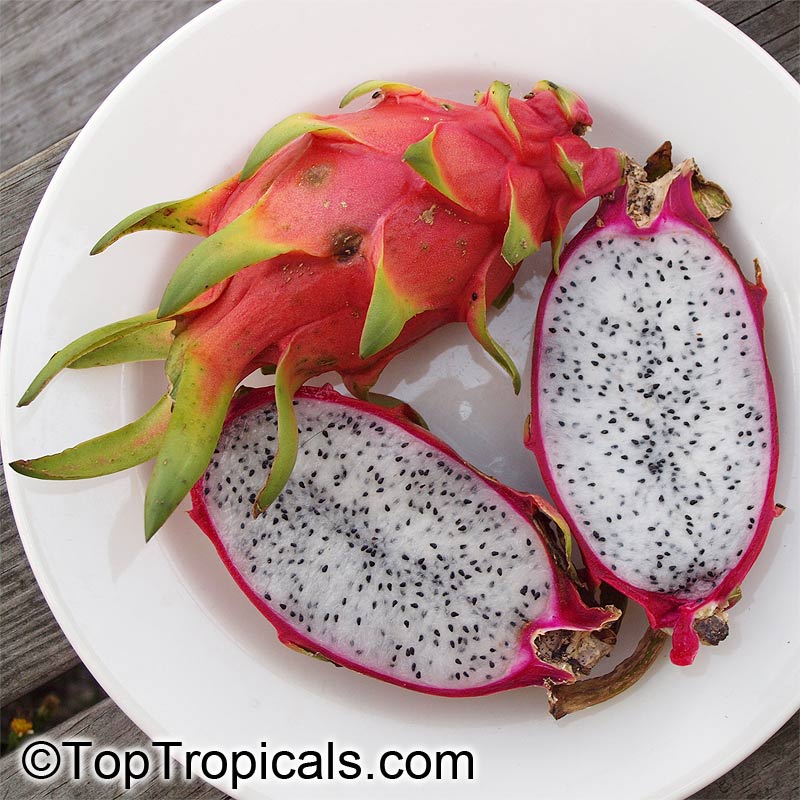
Hylocereus and Selenicereus Dragon Fruit or Pitaya
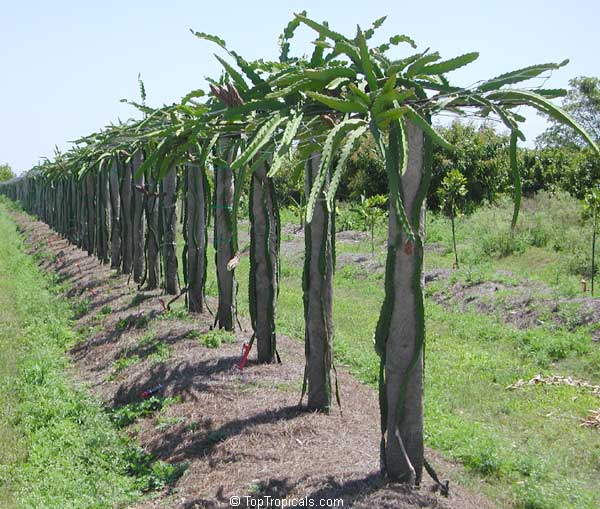
Hylocereus and Selenicereus Dragon Fruit or Pitaya trees on trellis
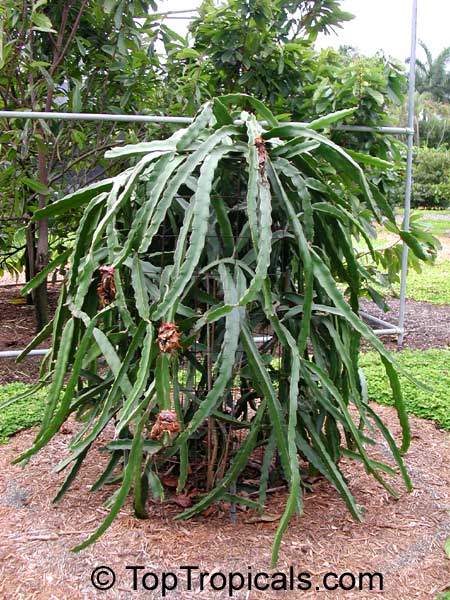
Hylocereus and Selenicereus Dragon Fruit or Pitaya on trellis

Hylocereus and Selenicereus Dragon Fruit or Pitaya red fruit
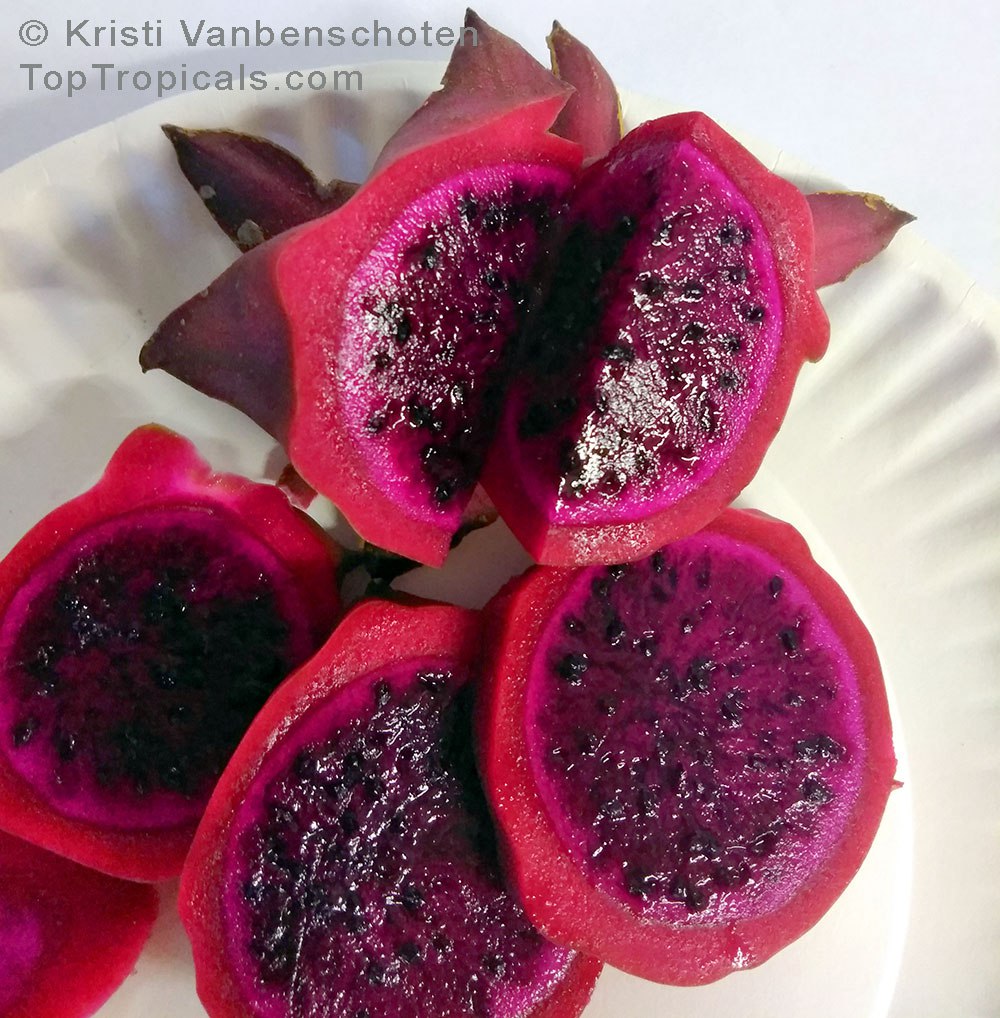
Hylocereus and Selenicereus Dragon Fruit or Pitaya purple fruit
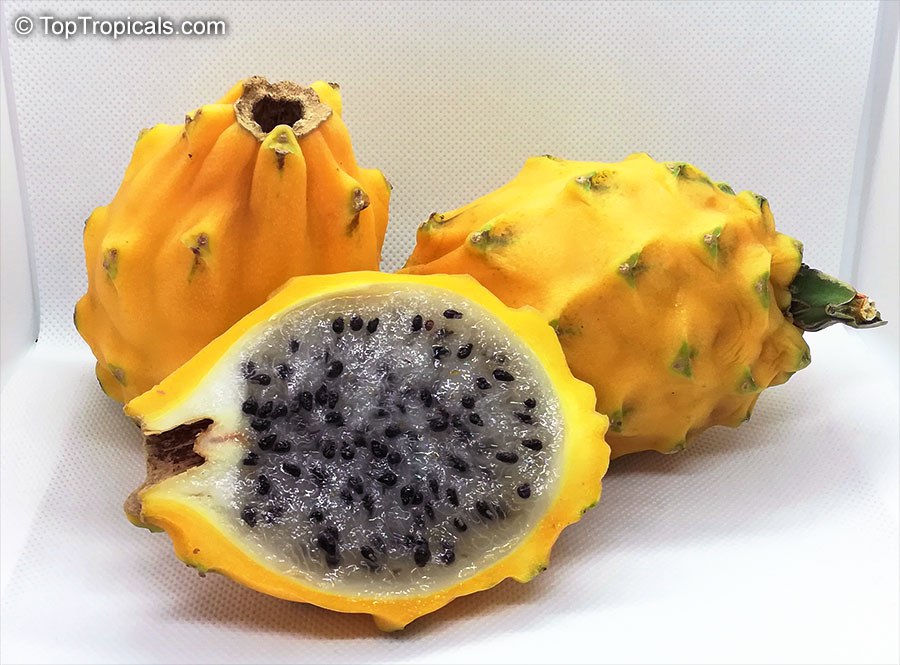
Hylocereus and Selenicereus Dragon Fruit or Pitaya Yellow Parlora
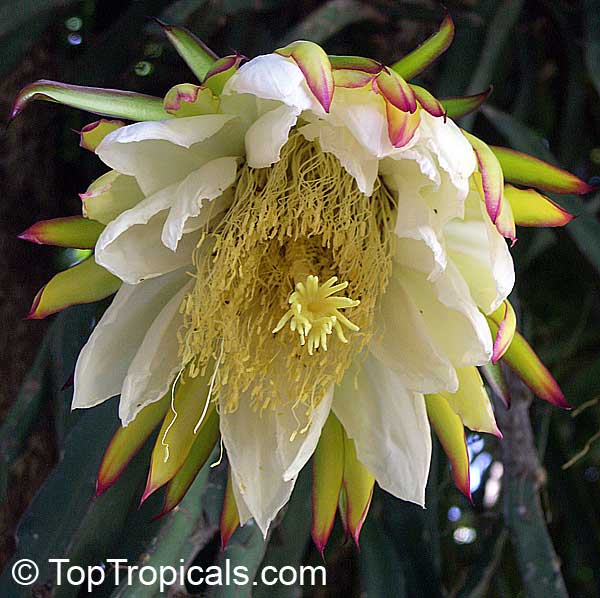
Hylocereus and Selenicereus Dragon Fruit or Pitaya flower
- 🔴 You may have tried a Dragon fruit from the store l, but do you know how it grows? On a cactus tree!
- 🔴 Names: varieties of Hylocereus and Selenicereus - these fruit bearing cactus plants are also called Dragon Fruit or Pitaya.
- 🔴 Commercially grown fruit sold in a grocery store may be tasteless. You need to grow your own good variety to have tasty, sweet, flavorful fruit!
- 🔴 Dragon fruit comes in many varieties. Colors of flesh differ: white, pink, dark red and even purple. The outside of the fruit can be red/pink or yellow.
- 🔴 In commercial groves, Pitayas grow like cactus trees, over a strong support - big "umbrella frames" ☂️
- 🔴 It is an easy plant, with low water needs, takes both sun and semi-shade.
- 🔴 Our favorite variety is Yellow Dragon Fruit Palora, (Selenicereus megalanthus). It is the sweetest and has the most flavor of all. We shared some recipes earlier.
- 🔴 Can be grown in container with a wooden trellis. And the flower is beautiful, too!
📚 Learn more about Dragon Fruit
🍹 Recipe: What to do with a Dragon fruit?
🛒Grow your own Tasty Dragon Fruits
#Food_Forest #Recipes #Nature_Wonders
🏵 TopTropicals
What tropical fruit tree is cold hardy and easy to grow? Its Golden Loquat the Symbol of Prosperity, and it tastes like
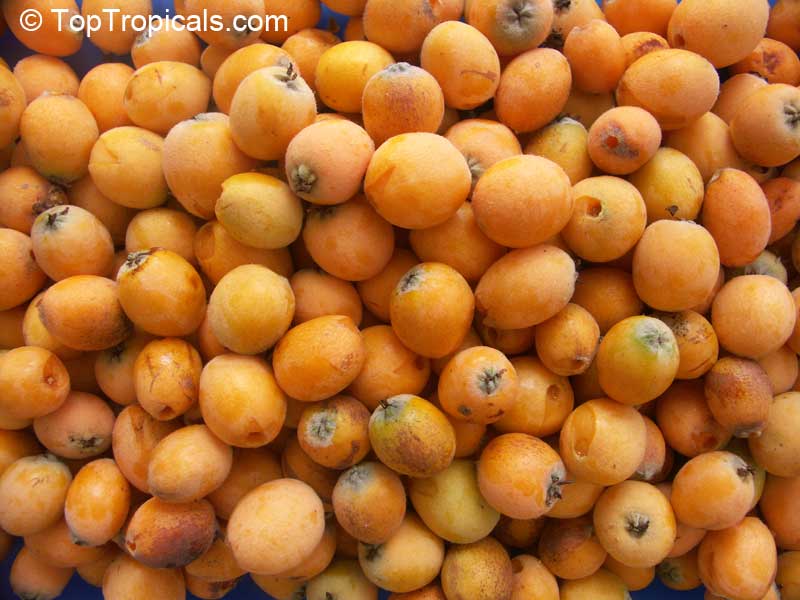
Loquat (Eriobotrya japonica) fruit

Loquat (Eriobotrya japonica) trees in pots
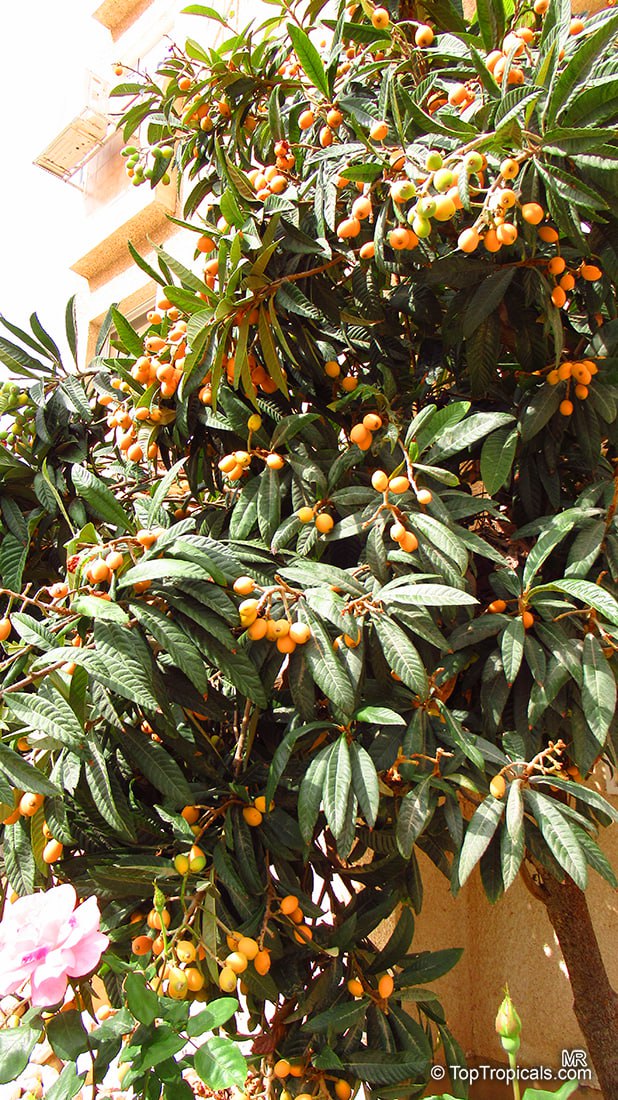
Loquat (Eriobotrya japonica) tree
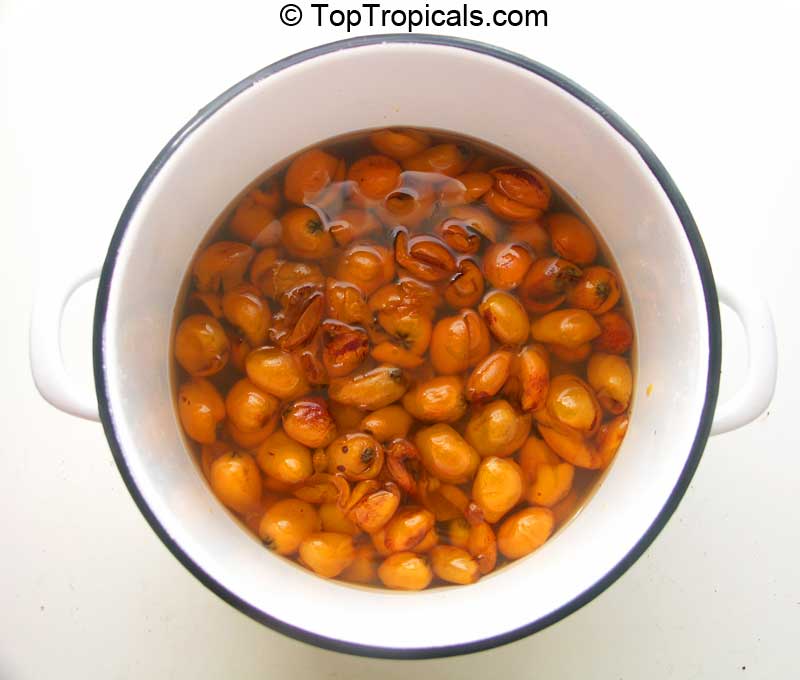
Loquat (Eriobotrya japonica) compot
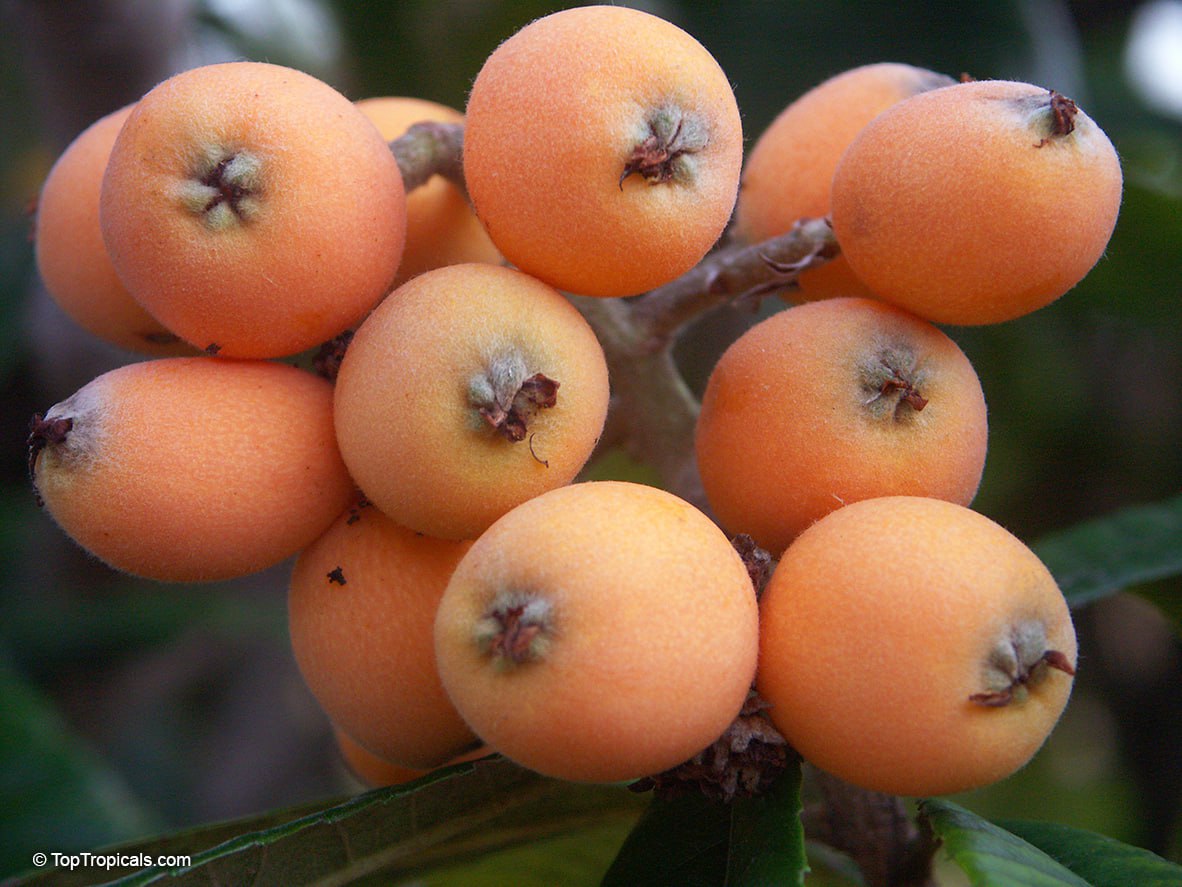
Loquat (Eriobotrya japonica) fruit
- 🍑 Loquat tree (Eriobotrya japonica) is fast-growing, drought-tolerant, cold-tolerant, compact tropical fruit tree.
- 🍑 Heavy producer. Fruits are juicy, aromatic, and resemble apricots. Ripen from early Spring to early Summer.
- 🍑 Ideal for small gardens, beginner fruit tree growers.
- 🍑 High in sugar, acids, vitamins B and C, minerals, and pectin.
- 🍑 Eaten fresh, used in fruit salads, jams, jellies, chutneys, pies, tarts, and wine
- 🍑 Grown in Japan for over 1,000 years. In China, represents gold and wealth, often included in auspicious displays or offerings for prosperity💰
Popular as a natural sweetener and for creating sauces.
📚 Learn more about Loquats
'>🎥 YouTube video about Loquat
📁 Overlooked fruit: tasty Loquat recipes (PDF)
🛒Start your fruit garden with Loquats
#Food_Forest #Recipes
🏵 TopTropicals
Date:
10 tips how to care of tropical
garden
during hot Summer
Q: Do you have any special recommendations how to take care of plants during hot season, to reduce heat strees?
A: Tropical plants prefer temperatures of 70-90F, except for heat-adapted desert plants. High temperatures above 90F can cause slowed metabolism and signs of stress like wilting, yellowing, and leaf drop. Hot and humid conditions attract pests and fungal diseases. To keep your plants stress-free and healthy, during Summer:
1. Monitor temperature and signs of stress.
2. Provide shade to regulate heat exposure: use shade cloth or simply a sheet of fabric as needed to protect lush foliage from burns.
3. Choose heat-tolerant plant varieties.
4. Plant in groups and levels, with trees protecting smaller shade loving plants (see companion planting).
5. Water deeply in the morning or evening to prevent evaporation.
6. Mulch to conserve moisture and regulate soil temperature.
7. Air: ensure good air circulation.
8. Trim damaged foliage and crowded branches.
9. Fertilize: use appropriate fertilization to improve plant heat tolerance. Remember, plants need lots of food during active growth period.
10. Remove weeds, pests, and diseases promptly.
In the photo: Tibouchina multiflora (grandifolia) - Glory bush, Quaresmeira, one of the most impressive flowering plants for tropical gardens, with impressive, large velvet leaves and beautiful purple flowers. It blooms in both sun or shade!
Date:
Blue Sage: Winter Wonder
Q: I am looking for some interesting shrub that will flower in shade and doesn't grow too big. I am a snow bird, living in Florida during winter and will appreciate a winter bloomer.
A: In the shady corners of the tropical garden, the Eranthemum pulchellum, affectionately known as Blue Sage or Lead Flower, emerges as a vibrant winter surprise. Its petals boast a bright gentian blue hue, a hue so unusual in the tropics that it's as if the plant got a memo about standing out in a sea of green.
This botanical maverick flaunts its blossoms when the rest of the garden is caught napping, making it the prima donna of the winter bloomers. With a penchant for the shadows, the Blue Sage is the introvert of the garden, thriving in the cool embrace of shade. So, if your garden needs a touch of cool and a dash of mystery, invite the Blue Sage - the shade-loving sensation that's always fashionably late to the blooming party.
Blue Sage is an easygoing champ in your garden. You can trim it how you like, and guess what? The more you trim it, the bushier it becomes. This plant doesn't mind shade, and when winter hits, it shows off its bright flowers, making your garden extra pretty without any fuss. So, if you're all about simple gardening joy, the Blue Sage is your go-to pal that turns your garden into a happy, colorful spot.
Date:
Ten steps to Happy Gardening in 2023
Beginning of the year checklist
To assist our customers in creating a happy and enjoyable gardening experience this year, we consulted with our horticulturist to compile a list of ten recommended items. Here are the results...
1. A favorite. Get yourself a favorite small flowering plant that is compact, manageable, and easy. Such as Ground
Orchid. Keep it in a pot or plant in the ground by the entryway where it can
be seen often and enjoyed.
2. A fruit of your labor. You need at least one (or one more) fruit tree for your
garden, or for container culture if you live in colder climate. Growing and
especially harvesting tropical fruit will make you happy. The Winner of the last
year was Cherry
Lolita - an easy, compact fruit tree that can produce almost year
around. Some fruit
trees will fruit right away!
3. Be exclusive. A rare plant is a must for every gardener. It can be a useful gem such as
Noni Tree
or an unusual-looking like a Bat Lily - Tacca. Show your friends and neighbors something different
they have never seen!
4. Make it cool. Finally plant that shade tree by your driveway. Yes it takes time to grow, but the sooner
you plant it, the sooner you get that shade! There are some fast growing species, some only take a couple of years to the mature
size.
5. Beauty. If you have an ugly fence or unwanted view in your yard,
cover it with a
flowering vine. Look at the beauty every day and make your life better.
Replace a boring standard hedge with colorful flowering shrubs that will make you smile.
6. Scent. Add some fragrant plants to your landscape and inhale their healing magic.
7. Tropical. For a shady corner, select a showy tropical with lush foliage such as Philodendron or Monstera, or
all time favorite
Banana. Get a feel of tropics.
8. Happiness of giving. Buy a gift plant for someone you care about but don't know how to thank them.
Live plant is the best expression of love and gratitude. If you are unsure
what plant to pick, ask our Team or simply buy a Gift Certificate that will never expire - let them chose the plant they
like.
9. Food for all. A set of quality liquid fertilizers is a must - try Sunshine Boosters that can be used year around. They will make your
plants healthy, strong, fast growing, cold hardy and disease-resistant. You can
choose formulas for different plant types from our selection, or simply buy online a Nutrition Kit of 8 bottles that will cover all your needs and save you
50% on fertilizer cost!
10. Share. Subscribe your friend to TopTropicals Newsletter so they can get a weekly Piece of Tropics in
their mailbox. Cool Cat Photos come as a bonus!
Make sure to always have on hand at least 2 main formulas of Sunshine Boosters - Robusta for vegetative growth, and C-Cibus that will satisfy plant needs for both fruit production and profuse flowering



